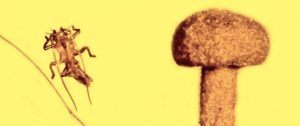
Thousands of insects, plants and other life forms have been found trapped in ancient amber deposits, but a new discovery shows a rarity of a different type – the one that got away.
In a piece of Baltic amber about 50 million years old, research has uncovered an exoskeleton similar to that of a modern-day “walking stick” – evidence of an insect that literally was frightened out of its skin, and made its way to freedom just as it was about to become forever entombed by oozing tree sap.
The unusual piece also reveals the first mushroom that’s ever been found in Baltic amber, along with a mammalian hair that was left behind. In its entirety, the amber piece offers a little docudrama of life, fear and hasty escape in the ecology of an ancient subtropical forest.
The findings were just published in Fungal Biology by George Poinar, Jr., a researcher in in the College of Science at Oregon State University and an international expert in ancient life forms found in amber.
“From what we can see in this fossil, a tiny mushroom was bitten off, probably by a rodent, at the base of a tree,” Poinar said. “An insect, similar to a walking stick, was probably also trying to feed on the mushroom. It appears to have immediately jumped out of its skin and escaped, just as tree sap flowed over the remaining exoskeleton and a hair left behind by the fleeing rodent.”
Plants, insects and other material found in amber deposits, Poinar said, always offer details about ancient ecosystems. But on rare occasions such as this, they also show the interactions and ecology between different life forms. They are invaluable in helping scientists to reconstruct the nature of ecosystems in the distant past.
In this case, the amber came from near the Baltic Sea in what’s now Germany, Poland, Russia and Scandinavia. It was formed, beginning as a viscous tree sap, in a large subtropical coniferous forest across much of northern Europe that lasted about 10 million years.
In a climate much warmer than exists there today, the early angiosperms, or flowering plants, were starting to displace the gymnosperms, or cone-bearing evergreens that had previously been dominant. Dinosaurs had gone extinct a few million years before, and mammals were beginning to diversify.
“The tiny insect in this fossil was a phasmid, one of the kinds of insects that uses its shape to resemble sticks or leaves as a type of camouflage,” Poinar said.
“It would have shed its skin repeatedly before reaching adulthood, in a short lifespan of a couple months. In this case, the ability to quickly get out of its skin, along with being smart enough to see a problem coming, saved its life.”
The exoskeleton seen in the amber is extremely fresh and shows filaments that would have disappeared if it had been shed very long before being covered by amber, Poinar said.
This particular insect species is now extinct, as is the mushroom in the fossil, Poinar said. Although mushrooms have been found in fossils from other regions of the world, this is the first specimen to be identified in Baltic amber, and represents both a new genus and species.
The Baltic amber deposits are the largest in the world, have been famous for thousands of years and continue to be mined today. Amber from the mines were traded by Roman caravans, later taken over by Teutonic knights and are known around the world for the huge volume of semi-precious stones they produce.
Reference:
George Poinar, A gilled mushroom, Gerontomyces lepidotus gen. et sp. nov. (Basidiomycota: Agaricales), in Baltic amber, Fungal Biology (2016). DOI: 10.1016/j.funbio.2016.06.008
Note: The above post is reprinted from materials provided by Oregon State University.










